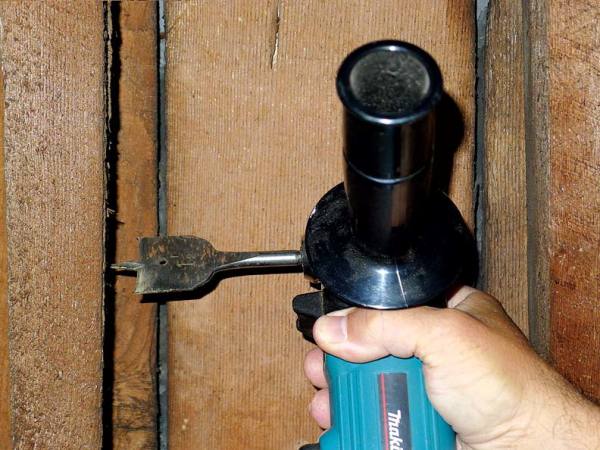
A right angle drill fits easily into the space between wall studs.
When you’re restoring an old house, it’s not uncommon to need to drill a single hole or a series of holes in wall studs or floor joists to accommodate wiring or plumbing. And after just a few minutes into the project, you’re likely to discover that, although you’ve carefully mapped the route, you can’t drill the holes because your drill and bit are too long to fit into the space between the joists.
You can try drilling angled holes, but this probably won’t create the neat passages you need. If the length difference is relatively small, a short spade bit might work. If not, you need a right angle drill.
What to Look For
Many manufacturers produce a line of right angle drills. They look just like typical corded or cordless drills, except they have a geared head that rotates the chuck at 90 degrees to the axis of the body. Without the bit, the head (including the chuck) is only a few inches long, much smaller than an ordinary drill. (Despite the smaller size, right angle drills still can accommodate most ordinary bits.) This design allows you to work in tight places that otherwise would be impossible to reach.
One thing you’ll notice when you use a right angle drill is that you can’t exert pressure on the bit with the hand holding the drill, as you would with a regular drill. Rather, pressure is best applied to the back of the drill head with your other hand. Most manufacturers offer handles that screw into the side of the head so you can apply pressure where it’s needed.
When you’re comparing drills, keep in mind that the shorter the main body of the drill is, the easier it will be to control. I also find that a small light built into the body of the drill is a helpful feature—chances are, if you’re using a right angle drill, you’re already in a tight spot, so any additional lighting is beneficial.
On average, a good-quality right angle drill will set you back around $200, so if you’re working on a small project that only requires boring a few holes, purchasing a full right angle drill might not make financial sense. In this case, you can get a right angle attachment with a shaft that you can chuck into your existing drill. This rotates gearing inside a closed housing and changes the output angle at the chuck by 90 degrees. The result is a light-duty version of the right angle drill. (If you’re looking at serious plumbing or electrical work, however, or if you’re going to be drilling through tough material such as oak, iron, or stone, go ahead and spring for the full drill.)
The Bottom Line
A right angle drill will be the one you reach for when you need to drill close to a corner or when you’re working through a small hand hole to attach an outlet box to a stud. These drills also can be fitted with screwdriver bits for fastening in tight spaces. Although it seems specialized, the right angle drill is a handy tool that will definitely pay for itself over time.







